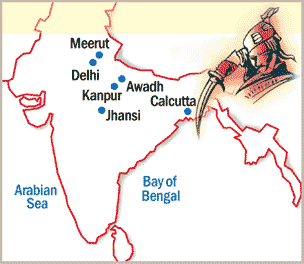
Meerut
On May 9, 1857, 85 Indian soldiers created a sensation by refusing to obey orders
from the British.
They refused to bite the new cartridges that, they believed, were laced with pig and cow fat because it was against their religious beliefs.
All of them were humiliated publicly and later sentenced to 10 years'
imprisonment by Major General William Henry Hewitt.
The next day, rebellion broke out in the 3rd Light Cavalry; it was the
beginning of the First War of Indian Independence.
The soldiers liberated Meerut from the British in no time as more and more
Indians joined hands. |
Delhi
After liberating Meerut the soldiers marched to Delhi and captured the
city on May 11.
The last Mughal emperor, Bahadur Shah Zafar, who was running a puppet
government with actual power vesting in the British, was quickly restored to
the throne, with Indian soldiers promising to end British rule in India under
his leadership.
The British, however, fought back and regained Delhi on September 14, entering
it from the Kashmiri Gate. This brought the curtain down formally on 332
years of Mughal rule in India. |
Awadh
The British had exiled the ruler Nawab Wajid Ali Shah unceremoniously to
Calcutta in 1856.
When news of the Meerut and Delhi mutiny reached Awadh the first sign of
rebellion came from Sitapur in June and then started spreading to other
districts.
On June 30, British and Indian soldiers fought a decisive battle at
Chinhat, 90 km from Lucknow, which the freedom-fighters won. Sir Henry
Lawrence was badly injured in the battle and died on July 4.
The rebellion in Awadh was mainly led by Wajid Ali Shah's wife Begum Hazrat
Mahal, with the help of the Kanpur ruler, Dhondu Pant or Nana Sahib.
But the British took back Awadh in March 1858, following the siege of
Lucknow. Begum Hazrat Mahal escaped with her son Birjis Qadr to Nepal and
died there in 1879. |
Kanpur
It was one of the bloodiest theatres of war as Nana Sahib along with his
lieutenants Azimullah Khan and Tantya Tope valiantly fought the British.
Nana Sahib was the adopted son of Peshwa Bajirao the Second and led the
Indian mutineers.
However, they could not hold the city of Kanpur for long as the British
threw all their might at them.
The battle continued till mid-1858 and seeing the imminent British victory,
Nana Sahib, Azmiullah Khan and Tantya Tope escaped.
Nana Sahib and Azimullah Khan were never seen again, but Tantya Tope was
arrested in April 1859 and hanged. |
Jhansi
This was the last bastion of the first Indian rebellion against the British.
Rani Laxmibai led the rebellion against the British and became an
everlasting symbol of our freedom struggle.
She died fighting the British and 150 years later, Indians still recall her
legend with pride. |
Calcutta
Some miles outside Calcutta, in Barrackpore, was the 34th Native Infantry. Among Her Majesty's loyal sepoys was Mangal Pandey, whose brief rebellion over the new ammunition on March 29 sparked off the 1857 Mutiny. Pandey was put down in a matter of minutes, but the emotion he set off, exploded in the sepoy mutiny 40 days later in distant Meerut. |
|